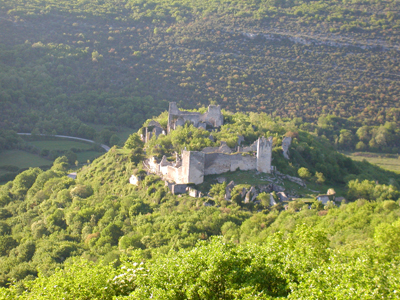

Dvigrad Castle is one of the few genuine castle from the medieval age that were kept in its original appearance. Dvigrad Castle is situated in the Draga valley on the Istria peninsula it is 11 km from Rovinj and 27 km from Pula. The name "Dvigrad" means “two cities” in Croatian and originally was used to describe two cities. However the other sister city of Parentin that was located on the southern side of the valley disappeared over the ages. There have been no organized archaeological digs on that site. So the name stayed with the northern settlement of Moncastello that was renamed to Dvigrad or Duecastelli. Few tourists and locals visit this location and that partially explains why the ruins are in fairly good condition. Today you can see well preserved three main gates, two rings of city walls and impressive towers. Dvigrad castle was not touched by reconstruction so be careful where you walk.
Location: Central Istria Map
Constructed: current walls erected in the 11th century
The site of Dvigrad Castle was occupied since the ancient times by the Illyrian tribes. Its strategic location over the valley that linked Adriatic shore and the inner valley of Istria made this city a centre of commerce. Dvigrad prospered in the Roman times, but with arrival of barbarian tribes lost much of former splendor. New Slavic tribes settled the region. Soon Benediction monks- missionaries followed. New Dvigrad fortification walls were erected in the 11th century. In the 13th century a church of Saint Sophia was constructed. It had three naves. Majestic frescos and reliefs covered the interior of the cathedral, reflecting city wealth and importance as a crossroad of the South Central Europe.
Dvigrad proved to be too rich for its own good. Since the beginning of the XIV century the city was attacked repeatedly. In 1345 Dvigrad was captured and burned by the Genoa admiral Paganin Doria. In revenge Venetians retook whatever was left of the citadel in 1383 and burned it again. Most of citizens were killed and the remaining possessions stolen. Basilica of Saint Sophia with its residents (known as Dvegrajci) that tried to find refuge inside were not spared. Since 1413 Venetian governor (podestat) ruled over Dvigrad and it was forced to pay annual tribute of 390 liras.
The fifteen century brought Dvigrad Castle waves of plagues that greatly decreased the population. Further wars between Venetians and Austrians in the 16th century over disputed lands brought more violence and bloodshed to the region. In the early 17th century the ruins of the city were inhabited by poor families who had nowhere to go. In 1650 bishop Tommasini visited the castle and reported only three families who lived there. In 1714 Dvigrad was finally abandoned and became a ghost town.
Ever since it became a ghost town Dvigrad Castle gained a fame of being haunted. Many locals reported strange noises as well as white apparitions that are said to roam abandoned ruins. Some even claimed that during one of the sieges the owner of the citadel hid his treasures in the castle wall. It is hard to say whether these accounts have any base on true events from history or merely a product of imagination, but legends are still interesting and captivating.